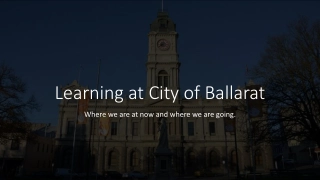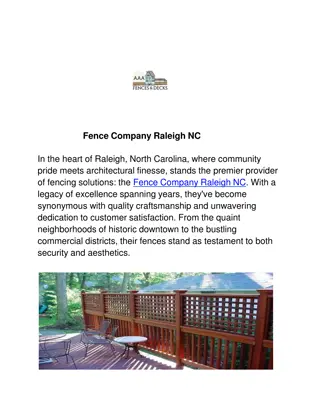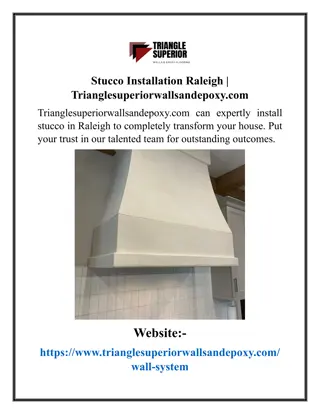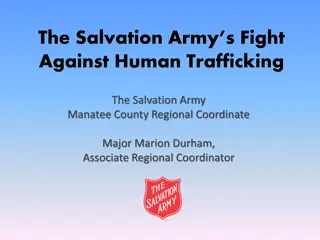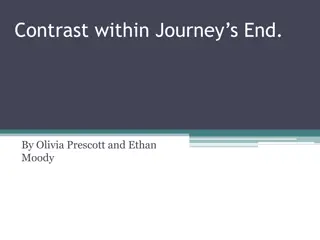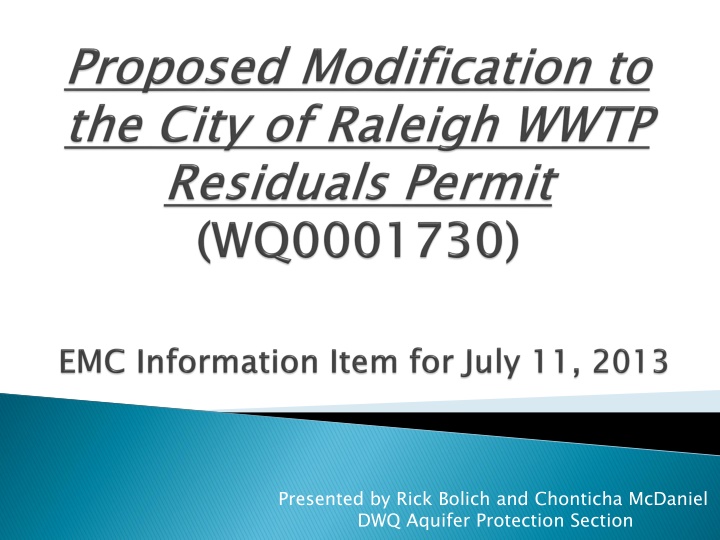
Aquifer Protection in City of Raleigh Public Utilities Department Case Study
In this case study, the City of Raleigh Public Utilities Department (CORPUD) faced groundwater contamination due to over-application of biosolids from the Neuse River Wastewater Treatment Plant. This led to fines, remediation efforts, and the implementation of natural attenuation methods. Learn about the challenges, corrective actions, and ongoing monitoring efforts to protect the aquifer and Neuse River from nitrate contamination.
Download Presentation

Please find below an Image/Link to download the presentation.
The content on the website is provided AS IS for your information and personal use only. It may not be sold, licensed, or shared on other websites without obtaining consent from the author. If you encounter any issues during the download, it is possible that the publisher has removed the file from their server.
You are allowed to download the files provided on this website for personal or commercial use, subject to the condition that they are used lawfully. All files are the property of their respective owners.
The content on the website is provided AS IS for your information and personal use only. It may not be sold, licensed, or shared on other websites without obtaining consent from the author.
E N D
Presentation Transcript
Presented by Rick Bolich and Chonticha McDaniel DWQ Aquifer Protection Section
City of Raleigh Public Utilities Department (CORPUD) Neuse River Wastewater Treatment Plant Generates 35 40 dry tons/day of residuals Maintains over 1,000 acres of fields adjacent to the WWTP for residuals disposal. Over-application of Biosolids Led to Groundwater Contamination from Nitrate Contamination has spread beyond compliance boundaries Residential wells also impacted
DWQ Modified Permit in 2002 to Cease Further Application of Biosolids on City- Owned Fields CORPUD Fined $74,000 for Over-Application CORPUD was Required to Perform a Site Assessment and Submit a Corrective Action Plan for Active Groundwater Clean-Up
Due to Size and Cost ($81M) of Active Remediation, CORPUD Submitted a Variance Application to Allow the use of Natural Attenuation in Lieu Of Active Treatment CORPUD provided free municipal water to all nearby residents Active groundwater containment implemented in certain areas of site Artificial wetlands were constructed in several areas to remove nitrate before it entered on-site streams
DWQ Modified COPRUDs NPDES Permit to Account for Nitrogen Load Into Neuse River from Groundwater Discharge Groundwater N load calculated by a groundwater model The amount of groundwater N that was calculated by the model was subtracted from the amount of N they were allowed to discharge in their NPDES permit.
Model-Calculated Nitrogen Loads From Fields to Neuse River
EMC Granted CORPUD Variance from Requirements of 15A NCAC 2L .0106(c) to Allow for the Use of Natural Attenuation of Groundwater Nitrate in November, 2009 Beginning in January 2014 and every five years thereafter, the City shall: Evaluate the effectiveness of the overall remediation strategy. Review of modeling results against observed data. Collect any additional data and information to improve model calibration.
Resumption of the residuals application activity on selected areas of the site (354 acres). Proposed re-application areas were identified (by the City) using predictive hydrological modeling: Low potential to further impact groundwater at the site s compliance boundary (CB). Resumption of residuals application is predicted to have no impact on the time it will take for the site to comply with groundwater standard for Nitrate at the site s CB. The net amount of N discharged into the Neuse River by the WWTP is predicted to remain under the allowable credits.
Resumption of the residuals land application on the proposed areas. Permit is updated to meet the most current administrative code 15A NCAC 02T.1100 rules (adopted Sept. 2006).
Apply residuals at or below agronomic rates. Install and operate three Vadose zone monitoring stations which are intended to detect NO3-N passing through the plant root zone. Continue monitoring of GW quality in 16 monitoring wells located throughout the site. Continue to meet all requirements that incorporated in the Variance and the most recent NPDES permit (NC0029033). Additional 50 GW monitoring wells and 29 SW monitoring locations
Draft Permit May 16th Public Notice May 22nd Public Hearing June 13th Public Comment Closed June 21st Hearing Officer s Recommendation Pending



